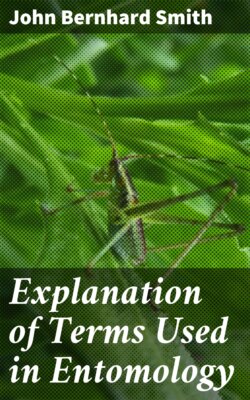Читать книгу Explanation of Terms Used in Entomology - John Bernhard Smith - Страница 7
На сайте Литреса книга снята с продажи.
B
ОглавлениеTable of Contents
Baccate -us: berry-like: applied to bladder-like ovaries from the surface of which the short ovarian tubes arise.
Back: the dorsum or upper surface.
Baculiform: rod or staff-like.
Badius: liver-brown; clearer and lighter than castaneus [dragon's blood].
Baenomere: a leg-bearing (thoracic) segment.
Baenopoda: the thoracic legs.
Baenosome: the thorax.
Balancers: see halteres.
Bald: without hair or other surface vestiture: see bare.
Band: a transverse marking broader than a line.
Bar: a short, straight band of equal width.
Barb: a spine armed with teeth pointing backward.
Barbate: furnished with barbs; hair with spines or spurs directed backward.
Barbated: bearded; in antennae with tufts or fascicles of hair or short bristles on each side of each joint; = brush-like: on the abdomen, with flat tufts at the sides or tip.
Barbule: a small barb, beard or filiform appendage.
Bare: without clothing of any kind: see bald.
Basad: in the direction of or toward the base.
Basal: at or pertaining to the base or point of attachment to or nearest the main body.
Basal area: in wings: that space nearest the point where they are attached to the body: on the metanotum of Hymenoptera, the anterior of the three median cells or areas = 1st median area.
Basal cell: Diptera; st (Will.), = radial 2 (Comst.); 2d (Will.), = media (Comst.); Trichoptera; one, two or three cells enclosed by the branches that form-the post-costal or anal vein: Odonata; an elongate cell between radius and cubitus, just before the arculus.
Basalis: the principal mandibular sclerite, when sclerites are distinguishable, to which all other parts are jointed; corresponds to the stipes in the maxilla.
Basal line: in many Lepidoptera; a transverse line extending half way across the primaries very close to base.
Basal lobe: of culicid genitalia, see claspette.
Basal post-costal vein: in Agrioninae, one of the cubito-anal cross- veins.
Basal segment of clasp: see side piece.
Basal space: that area on the primaries of certain Lepidoptera, between the base and t. a. line (q.v.).
Basal streak: in Noctuid moths, extends from base, through the submedian interspace to the t. a. line.
Basal transverse carina: on the metanotum of Hymenoptera, crosses before middle and separates the anterior from the median areas.
Base: that part of any appendage that is nearest the body: on the thorax that portion nearest the abdomen; on the abdomen that portion nearest the thorax.
Basement membrane: that thin layer of tissue upon which the epithelium rests.
Basilar: of or pertaining to the base.
Basilar cross-vein: Odonata; crosses the basilar space.
Basilar membrane: a thin membrane separating the cones and rods from the optic tract.
Basilar space: Odonata; that area at base of wings, between media and cubitus.
Basi-proboscis: basal third of the flexed proboscis of muscid flies.
Batesian mimicry: see mimicry.
Bathmis: see pterostigma.
Bave: the fluid silk as it is spun by caterpillars.
Beak: any notable prolongation of the front of the head: the snout in Rhynchophora: specifically, the jointed structure covering the lancets in the hemipterous mouth.
Bearded: fringed with hair: see barbated.
Belly: venter; under side of abdomen.
Belonoid: needle-like.
Bi: prefix, means two.
Bi-alar: two-winged; applied to Diptera.
Biarcuate: twice curved.
Biareolate: with two cells or areoles: see bilocular.
Bicaudate: having two tails or anal processes.
Bicolored: with two colors that contrast to some extent.
Bicornute: with two horns or cephalic processes.
Bicuspidate: ending in two points or cusps.
Bidactylate: with two fingers or finger-like processes.
Bidentate: two-toothed.
Biemarginate: twice emarginate; with two excisions.
Bifarious: pointing in opposite directions.
Bifasciate: with two bands or fascia.
